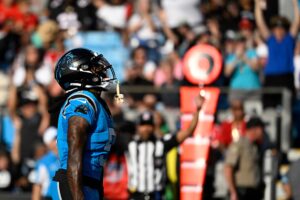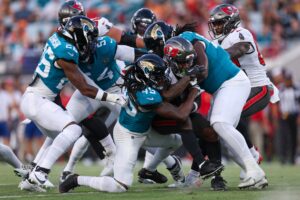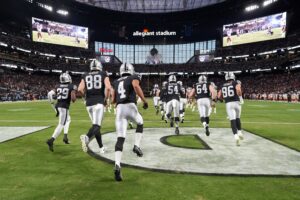In the NFL, teams are built through the draft before anything. A successful draft builds a deep roster that has cap flexibility. That cap flexibility gives them the ability to fill in remaining holes through free agency. If a team fails to draft well, teams often bank too much on free agency to fix their holes. Or, they look to undrafted free agents to step up.
In recent years, the New York Jets have done a great job at finding undrafted free agent talent, from Robby Anderson to Kyle Phillips. After years of poor drafting and free-agent signings, general manager Joe Douglas has a lot of cleaning up to do. Here is how the Jets can replicate their success with their 2020 undrafted free agent class.
How the New York Jets Can Replicate Recent UDFA Success
Strength, not Weakness
In the NFL, no player is perfect. Entering the league, Patrick Mahomes was thought to be reckless as a passer. Lamar Jackson was more of an athlete than a passer. Or Christian McCaffrey being too lean to be an every-down back. Rather than focusing on what they could not do, their teams capitalized on their strengths to limit their weaknesses and eventually fixed them.
For the Jets, that is exactly what they did with Robby Anderson. The Jets took advantage of his size and speed, using him as a downfield threat. Then, honing his game as a route running and adjusting his game to his smaller frame. For Kyle Phillips, the Jets used him all over the defensive line, utilizing his versatility and overall athleticism. Now entering year two, Phillips hopes to improve his instincts and run defense.
Analyzing the Group
Unlike most teams, the Jets have a rather small undrafted free agent class with just nine players. But it is a rather talented group nevertheless. It begins on offense with receivers Lawrence Cager and George Campbell. Both had similar paths in college, as they spent three years at one university before career years in 2019. Cager (6’5”, 220lbs) and Campbell (6’4”, 183lbs) both offer possession receiver potential with fantastic catch radiuses downfield. Along the offensive line, the team added Washington product Jared Hilbers. With great athleticism, Hilbers can be used as a swing tackle with good run blocking ability.
On the defensive side of the ball, defensive coordinator Gregg Williams has quite a few new chess pieces to work with. Defensive lineman Domenique Davis and Sterling Johnson look to carve out roles along a rather deep Jets front unit. Both are tone-setters up the middle with the size and athleticism to move along the defensive line. On the edge, the Jets inked Memphis edge rusher Bryce Huff. For a weak Jets pass rush, Huff offers speed and a relentless motor from the outside linebacker spot.
In the secondary, the Jets added three very different players in corners Javelin Guidry, Lamar Jackson and safety Shyheim Carter. The second-fastest player at the 2020 Combine with a 4.29-second 40-yard dash time, Javelin Guidry gives speed from the Nickelback position. The other Lamar Jackson in the NFL offers the Jets a big-bodied corner on the outside. Last but not least, Carter is an intelligent ballplayer who brings versatility that Williams loves as he can play the slot or safety.
How to Capitalize
Offense
With the loss of Robby Anderson, the Jets are in need of a big, playmaking receiver on the outside, an element that both Lawrence Cager and George Campbell can offer. Even if they struggle to create separation, head coach Adam Gase can use them in red zone sets with their size. With questionable talent at receiver, having at least one of them on the outside in the red zone can create mismatches that the Jets could use to open the middle of the field for tight ends Chris Herndon or Ryan Griffin.
General manager Joe Douglas made it clear that his priority this off-season was to protect quarterback Sam Darnold. Multiple additions through the draft and free agency have given the Jets plenty of flexibility along the line. But there remain questions if the injury bug falls on George Fant, Chuma Edoga or rookie Mekhi Becton. With Jared Hilbers’ size (6’6”, 310lbs) and versatility, Hilbers offers a backup who can play either side of the line in case of injury. For a young depth piece with plenty of experience at Washington, Douglas certainly is fond of Hilbers’ pro outlook.
Defense
The Jets defensive front has been built on stopping the run and versatility – which are exactly where Domenique Davis and Sterling Johnson excel. 2018 third-overall pick Quinnen Williams, veterans Henry Anderson and Steve McLendon, and plenty of young pieces such as Nathan Shepherd, Folorunso Fatukasi and Kyle Phillips are the headliners for the position group. Gregg Williams led an injury-riddled Jets to be one of the top defensive units by using his players’ strengths. Davis and Johnson are big, athletic bodies who can push the line, giving the Jets more opportunities to collapse the pocket from the edge.
Speaking of collapsing the pocket, that is exactly what Bryce Huff will need to do. Huff is undersized at just 6’1” and 254lbs but brings speed like no other edge defender the Jets have now. The only proven pass rusher on the roster is Jordan Jenkins, and they just spent a third-round pick on Florida’s Jabari Zuniga. With limited depth on the edge and in desperate need of a game-changer, Huff could be exactly that. With his explosiveness and determination, Gregg Williams will love to see what he can bring to this defense.
2019 Week 1 starting corners Trumaine Johnson and Darryl Roberts are gone. Pierre Desir is an experienced veteran who should start in one corner spot, although he is coming off of a down season himself. Quincy Wilson saw his role decrease with the Indianapolis Colts due to inconsistent play before being traded during the draft. And who knows if Williams can get the starting-level production out of Blessuan Austin, Arthur Maulet or Nate Hairston again.
Lamar Jackson should be able to fight for good reps early on, with the length to compete with the best of them solely on the outside. Javelin Guidry offers elite speed that the Jets have not had in a long time in the secondary, as well as on special teams. The same goes for Carter, who can compete for the fourth safety spot behind Jamal Adams, Marcus Maye and Ashtyn Davis.
Last Word on How the New York Jets Can Replicate Recent UDFA Success
NFL teams are built through the draft, free agency and undrafted gems. While the Jets have a small group of nine players, Gang Green has a handful who can be immediate role players starting Week 1 of 2020. Joe Douglas was brought in to change the Jets and develop them into a contending team built well from top to bottom. And nothing is more important than capitalizing on each and every player not by forcing them into difficult roles, but by their strengths.
New York Jets UDFA Main Photo:
Embed from Getty Images






